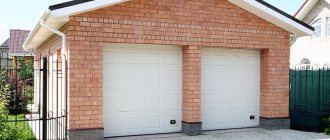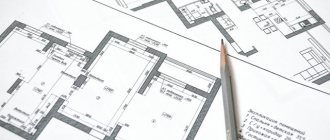Construction of a garage is work that in some cases requires obtaining a permit.
The process of issuing such a permit is regulated by Article 51 of the Civil Code of the Russian Federation, as well as Federal Law No. 93 on dacha amnesty and articles of the Civil Code of the Russian Federation. In some cases, the construction of such a building must be legalized by obtaining a permit. Read the article about cases when it is necessary to obtain a permit and information about which areas can be used to build a garage.
Where can you build?
You can build a garage, based on Article 51 of the Civil Code of the Russian Federation, in the following areas:
Allocated for individual housing construction (clause 17.1.1).- Not intended for business activities (clause 17.1);
- Defined on the basis of legislation in the field of horticulture and gardening as garden plots (clause 17.1).
- Belonging to a garage-construction cooperative. In this case, the garage is transferred into the ownership of the owner after full payment of the share contribution (Part 4 of Article 218 of the Civil Code of the Russian Federation).
In addition, permission is not required for the construction of non-permanent buildings, in other words, garages without a foundation and utilities (clause 17.2). However, it should be understood that such a structure will be extremely unstable and the risk of its destruction is extremely high.
Installation of garages near apartment buildings on territory that is not private property is considered as self-building. But this does not mean that the construction of such a building cannot be legalized. Such a procedure is possible, but it requires a lot of time and effort.
Construction without permission
You can build on your property without permission. This is written above. There are simply options, for example, on the site of an apartment building they give permission to build a garage, but a completely different object is being built. There are many lawsuits in the courts regarding this matter.
There are two types of decisions here:
- Once a structure is erected, it is simply demolished. There are no refunds, in any case.
- The second option is if construction is underway but not completed. Then a decision is made to suspend work and an order to demolish the structure.
Requirements
Let's consider the standards and requirements for fire, sanitary and construction safety:
To a separate object on a plot for individual housing construction or garden plot
As for the norms that must be observed when constructing such a facility on a site for individual housing construction, these are the norms of SNiP 2.07.01-89, which regulate the rules for the construction of buildings for utility purposes (this includes a detached garage):
The distance to buildings on the adjacent site should be:- 10 meters for reinforced concrete products;
- 8 – for concrete;
- 10 meters - in the case when one of the buildings is made of flammable materials, including wood;
- 15 – if the obi is built from such materials.
- If the partitions in the structure are made of wood, then the permissible distance must be increased by 2 meters;
- The distance to the fence between areas must be at least 1 meter;
- If there is a side passage near the site, then it is necessary to retreat from it at least 3 m;
- The distance from the central road must be at least 5 meters;
- If the garage is being built as a detached one, then there must be a distance of at least 3 meters from it to the residential building;
- In addition, when opened, the garage door should not block the movement of vehicles and pedestrians, and a car parked under a canopy should not block traffic on the road.
It’s better to add another half meter to these distances so that no questions arise.
If construction has not yet begun on the neighboring site, you can only comply with the norm for the distance to the fence . In this case, when constructing structures, the owner of the neighboring plot must take into account the distances specified in these SNiPs.
Bypassing the distances of these building regulations is possible only with the written permission of the owners of the neighboring site.
Even if SNiPs are advisory in nature, however, if the owner of neighboring plots can prove that a structure that was erected in circumvention of these norms infringes on their rights or causes a danger to their life and health in court, then the court will oblige the building to be moved in accordance with the requirements of these norms. And if the garage is a permanent structure, this is very problematic.
Red lines
In addition, when constructing a garage, or indeed any building on a private plot, it is necessary to build the building on the basis of established red lines - markings laid down in the master plan of the settlement.
This marking reflects the location of communications. Any building or structure must be located at a distance of at least 5 meters from these lines, otherwise the court may rule on the demolition of an object that violates this distance.
Fire regulations
In addition to the above standards, it is necessary to comply with fire safety requirements . This will not only secure the building, but also reduce the permissible distances to neighboring structures:
- There should be a fire shield and a fire extinguisher near the building;
- there should be no heating in the garage;
- the wiring goes through the in-house meter, is laid inside a metal sleeve and is made according to PTEEP;
- factory shades are installed on the light bulbs;
- fuses are installed.
Failure to comply with any of the above standards will affect the ability to locate the garage. We will have to carry out construction in accordance with SNiP.
In the basement or first floor of a residential building
When building a garage of such a layout, when it is located on the ground floor, there are also SNiP requirements:
- The upper part should protrude above the ground surface by at least 2 meters.
- The garage should go underground no more than half its height.
When constructing a structure on the ground floor, the requirements for the mandatory presence of a canopy must be observed in the case where the windows of the rooms are located above it.
General recommendations for both projects would be as follows:
- Sealing of ceilings and walls to prevent the penetration of exhaust gases into residential premises.
- Duct ventilation device.
- The use of non-combustible materials in the construction of walls and ceilings.
Otherwise, the safety requirements must be those of a detached garage.
In GSK
By becoming a member of the GSK, you can also start building a garage, a permit for which is issued by the cooperative itself.
However, in this case, it is worth understanding that the land on which GSK has developed its activities can be leased and owned by the municipality . Then there are risks of losing a capital asset in the event of termination of the lease.
In addition, ownership of the premises remains with the cooperative until the full payment of share contributions by its member. If you plan to build a detached garage on territory owned by GSK, it is better to apply for permission from the municipality. This will avoid problems with registering ownership of the structure after payment of share contributions.
In most cases, a garage built on cooperative land is made in the form of boxes with adjacent walls to other garages. In this case, the garage is not considered a building, but a room in a building - a number of adjacent boxes.
When constructing such a structure, it is also necessary to be guided by fire safety requirements , but otherwise, strict requirements for the project do not apply.
A detached garage on the territory of the GSK is an extremely rare phenomenon and is subject to the same requirements as for auxiliary buildings for utility purposes.
Required documents
To build a garage on the territory of an individual housing construction, regardless of its type, a building permit is not required. A construction permit on the territory of the GSK is issued by an authorized person of the cooperative and the list of documents is regulated in accordance with the charter.
In the case where the garage is intended to be used for business activities or the garage is located outside the territory for individual housing construction or civil construction, a permit will be required.
To do this, the following package of documents is required:
a document confirming ownership of the plot;- owner's statement;
- passport and a copy of the owner’s passport;
- technical plan of the site from BTI;
- construction project;
- cadastral map;
- utility network connection plan (if necessary);
- topographic map.
The list of the above documents is submitted to the architecture department and within a month permission to carry out construction work or a written refusal indicating the reasons will be given.
Do I need permission to build a garage on my land?
In the modern world, a car has become available to almost all segments of the population, but after the purchase, the car owner has a reasonable question: where to store the purchased vehicle. In standard situations, people begin to consider purchasing a garage, both on the primary and secondary garage real estate markets. But there is another opportunity to get a campervan for your car. If a citizen owns a plot of land or has a long-term lease, he can build a structure for a personal car on his own or with the involvement of professional builders. With the technical side, everything seems to be clear and simple, but what about the official part of the design of such a building? What actions are required from the owner (tenant) of the land plot? To have a proper understanding of the answers to these questions, you will need to consider all the nuances in more detail.
There are 2 paths, one of which can be followed by a person who has built a garage on his site:
- The first way will be the pre-construction preparation of all required documentation. That is, a person first obtains a building permit and only then builds a building.
- The second option would be to do the reverse sequence. First, the construction of the structure, and then the owner begins actions related to bringing the documentation into compliance with the letter of the law.
Refusal to issue
Circumstances in connection with which the architecture department may refuse to issue a permit:
- An incomplete list of documents has been provided.
- There is no confirmation of ownership of the site.
- The purpose of the site does not provide for capital construction.
- The garage design does not comply with fire safety requirements.
- The location of the garage does not comply with SNiPs.
- Installing a garage will prevent free passage.
If the reasons for refusal are eliminated, you can resubmit your application. If there are no grounds for a refusal, but the architectural department still does not give permission, then its actions must be challenged in court.
Papers for obtaining ownership of a garage
After construction is completed, it is necessary to take care of the ownership rights to the structure.
It is also necessary to register those buildings for which construction permits are not required . This will confirm the fact of ownership of real estate, and therefore allow them to dispose of it in full.
Depending on the type of garage, you will need to select a certain package of documents to register the building and ownership of it.
You can submit documents:
- personally;
- through a representative (then you will need documents confirming his authority);
- by mail;
- through MFC.
The results are obtained using the same methods.
To a separate building, on your own land
If a detached garage was built on land allocated for individual housing construction or other non-commercial use and does not violate the purposes for which the site was allocated, then it will require a very small package of documents:
- Certificate of title to a land plot.
- Garage declaration in two copies.
- Owner's passport.
- Technical plan prepared by a cadastral engineer.
- Extract from the Unified State Register of Legal Entities (if ownership is registered in the name of a legal entity).
- Receipt for payment of state duty.
According to Art. 333.33 of the Tax Code of the Russian Federation, the state duty for such registration will be 2 thousand rubles for individuals and 22 thousand for legal entities.
On the ground or first floor of a private house
If the garage was built as part of a house, then additional registration of ownership of such a structure is not required. It is considered a room in a house, the ownership of which will have to be registered one way or another.
In a garage-building cooperative
To register ownership of a garage located in GSK, you will need much more documents:
Application for state cadastral registration of real estate and (or) state registration of rights to real estate.- The applicant's passport or other identification document.
- Extract from the Unified State Register of Legal Entities (if ownership is registered in the name of a legal entity).
- Receipt for payment of state duty.
- A certificate of full payment of share contributions, which is signed by the chief accountant of the cooperative and an authorized person.
- A document that confirms the right to pension savings.
- Constituent documents of the cooperative, including all changes and additions.
- A document confirming the authority of the person who signed the certificate (we are talking about an authorized person, and not about the chief accountant of the cooperative).
- A document confirming GSK's ownership of the land.
- Permission to put into operation a facility built after December 30, 2004 or an acceptance certificate for a facility built before this date.
In addition, you will need to obtain a technical passport and a certificate of registration of ownership of the site. Otherwise, the structure will be considered an unauthorized construction and it will be impossible to register ownership of it.
All certificates are provided in two copies. Payment of the state duty will be the same as when registering ownership of a structure built on the territory of individual housing construction - 2 thousand for individuals, 22 thousand for legal entities.
How to legalize an already built garage
It often happens that the owner of the site built a garage, used it for some time, but did not consider it necessary to legalize this building. But due to the sale of a plot with a residential building, it became necessary for him to bring the real estate documentation into compliance with legal norms.
As a rule, this problem is resolved pre-trial, but in rare cases local authorities refuse to legalize a garage building. The reasons for this may be different. For example, a built garage is located too close to a neighboring plot of land, and the neighbors believe that their rights are being violated in this way. In such circumstances, it is recommended to study all the standards established by law. The best solution to such a problem would be a settlement agreement with neighbors. Only by obtaining written consent from them will the owner be able to resolve the issue of legalization.
The situation will be completely different if a person is confident that he has built a garage in accordance with all standards. In this situation, you should go to court. Before filing a claim, it is recommended to consult with a lawyer who specializes in such disputes. Before the trial, it is necessary to prepare evidence confirming the fact that the garage building does not violate the following points:
- The building is actually physically located on the plaintiff’s land;
- The norms and rules of construction and urban planning have not been violated;
- The rights of third parties (people living in the neighborhood) are not violated;
- Not dangerous.
If in court the plaintiff can prove all these facts, then he will win the case, and the unauthorized construction will be recognized as legal.
In recent years, legislators have been tightening the rules for legalization and, based on this, it is recommended that the procedure for registering real estate be carried out in advance.










